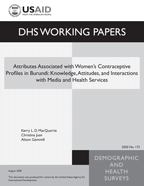- PUBLICATIONS
- JOURNAL ARTICLES
- ORDER PUBLICATIONS
Publications Summary
- Document Type
- Working Papers
- Publication Topic(s)
- Family Planning, Fertility and Fertility Preferences, Gender
- Country(s)
- Burundi
- Language
- English
- Recommended Citation
- MacQuarrie, Kerry L.D., Christina Juan, and Alison Gemmill. 2020. Attributes Associated with Women’s Contraceptive Profiles in Burundi: Knowledge, Attitudes, and Interactions with Media and Health Services. DHS Working Paper No. 173. Rockville, Maryland, USA: ICF.
- Download Citation
- RIS format / Text format / Endnote format
- Publication Date
- August 2020
- Publication ID
- WP173
Download
 Attributes Associated with Women's Contraceptive Profiles in Burundi: Knowledge, Attitudes, and Interactions with Media and Health Services (PDF, 396K)
Attributes Associated with Women's Contraceptive Profiles in Burundi: Knowledge, Attitudes, and Interactions with Media and Health Services (PDF, 396K)
Download this publication
There is no printed copy available to order.
